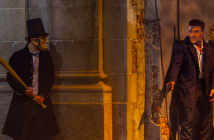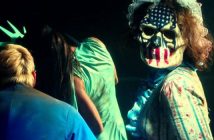
Editor’s Notes: The Legend of Tarzan is out in wide theatrical release today, July 1st.
Let’s try this again. Raise your hand if – in your finite or infinite wisdom – you petitioned Warner Bros. for another re-do, reimagining, or reboot of the Tarzan story first published over a century ago by pulp novelist Edgar Rice Burroughs. Now lower your hand if you happen to be associated or affiliated with Warner Bros. in any capacity whatsoever. That leaves the handful of potential moviegoers vaguely curious about The Legend of Tarzan, Warner Bros.’ ill-conceived $180-million gamble, and whether Warner Bros. and Harry Potter helmer David Yates (Fantastic Beasts and Where to Find Them) and his screenwriters, Adam Cozad (Jack Ryan: Shadow Recruit) and Craig Brewer (Hustle & Flow), could update and modernize an early 20th-century character deliberately constructed around the white savior trope for multi-ethnic, multi-cultural 21st-century audiences and everything that implies. Unfortunately, it’s a challenge – and in fairness, a daunting one – that Yates, Cozad, and Brewer ultimately can’t overcome.
As Tarzan, Skarsgård broods often, says little. and flexes a lot.

Points, though, for effort, even if that effort essentially recasts the Tarzan story into the comic-book superhero template contemporary audiences continue to embrace, however inexplicably. Cozad and Brewer lift Batman Begins’ flashback structure for The Legend of Tarzan, an astute, clever decision that helps them – and by extension, moviegoers – from retelling Tarzan’s origin story for the 150th time. We still get glimpses of that story via flashbacks, though. Tarzan, aka John Clayton, Lord of Greystroke (Alexander Skarsgård), survives the death of his parents as an infant in the jungles of darkest Africa, grows up as an adopted member of an ape tribe, becoming super-fit and super-ripped in the process. He also communes with the animals, learning their language and rhythms. As a practical example of a Nietzschian über-man, he also teaches himself how to read. In time, he meets Jane Porter (Margot Robbie), the daughter of a Christian missionary and educator, falls in love, and moves back to England to take up his duties as a different kind of lord.
The Legend of Tarzan repeatedly fails to escape its origin as an early 20th-century example of stereotypical, caricatured storytelling . . .
When we first meet Clayton, he seems perfectly content to play lord of the manor with Jane, but a request from Britain’s political leaders to return to the Belgian Congo as a diplomat to negotiate a trade deal makes his return to Africa a practical inevitability. It takes a push from George Washington Williams (Samuel L. Jackson), a U.S. diplomat with an agenda of his own – he wants to ferret out evidence of the Belgian government’s mistreatment of the native population, up to and including enslavement – to present to the world, to convince Clayton to do the right thing. Jane doesn’t share her husband’s reluctance. She’s eager to return to her adopted home and reunite with old friends. To quote the perennially useful Admiral Ackbar, however, “It’s a trap,” a trap created by Leon Rom (Christoph Waltz in literal mustache-twirling mode), to win favor with an African chieftain, Mbonga (Djimon Hounsou), who harbors a grudge against Tarzan, and gain access to the blood diamonds that will rescue the Belgian king from bankruptcy.
From there, The Legend of Tarzan devolves into rescue mission mode. Despite her protestations to the contrary, Jane turns into damsel in distress mode. Once she falls into Rom’s clutches, there’s little for her to do except futilely try to escape or warn Rom of Tarzan’s impending arrival and what it means for Rom’s future in Africa (i.e., he doesn’t have one). It’s a poor use of Robbie’s talents and thus all the more disappointing. Tarzan grunts and growls his way through the jungle, meeting up with old friends, including his ape family (impressively rendered in CGI), and old foes, with Williams as comic relief/sidekick/exposition magnet. As Tarzan, Skarsgård broods often, says little. and flexes a lot. Jackson talks nonstop and gesticulates wildly, a typically overbroad performance that could be read as offensive given the context. Outside of his hyper-stylized performances with Quentin Tarantino, however, Jackson’s style seems ill-suited for a historical action film (most likely because it is).
Try as Yates, Cozad, and Brewer might, The Legend of Tarzan repeatedly fails to escape its origin as an early 20th-century example of stereotypical, caricatured storytelling (an avowed eugenicist, Burroughs was a firm believer in the “natural” superiority of the white race). The exoticized Africans we meet in The Legend of Tarzan worship Tarzan as a near deity, repeatedly singing a song about his exploits, embracing him as a leader and later, standing in a semi-circle high above a port city applauding his heroic efforts to remove Rom – a character based on a real-life Belgian official even crueler and more despotic than depicted here – and the brutalistic, imperialistic Belgians from their land. Without a white savior of Tarzan’s near superhuman abilities, history wasn’t so kind to the Belgian Congo and its people (Rom lived to a relatively ripe old age). Then again, it’s hard to imagine a reason or rationale for mixing history and fantasy, fact and fiction into a reimagining no one needed, let alone wanted.
It’s a poor use of Robbie’s talents and thus all the more disappointing and while, as Tarzan, Skarsgård broods often, says little. and flexes a lot. It’s hard to imagine a reason or rationale for mixing history and fantasy, fact and fiction into a reimagining no one needed, let alone wanted.



